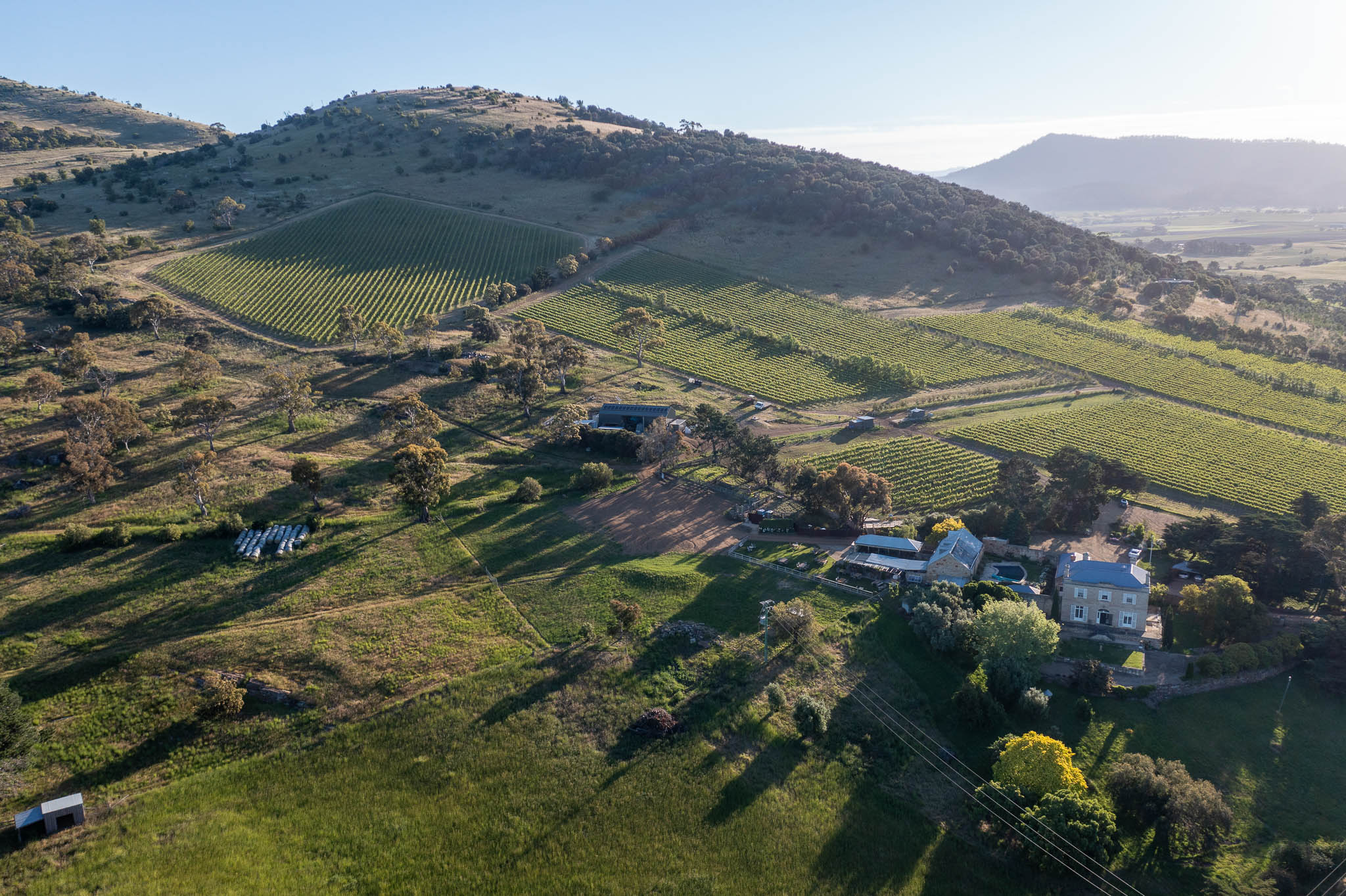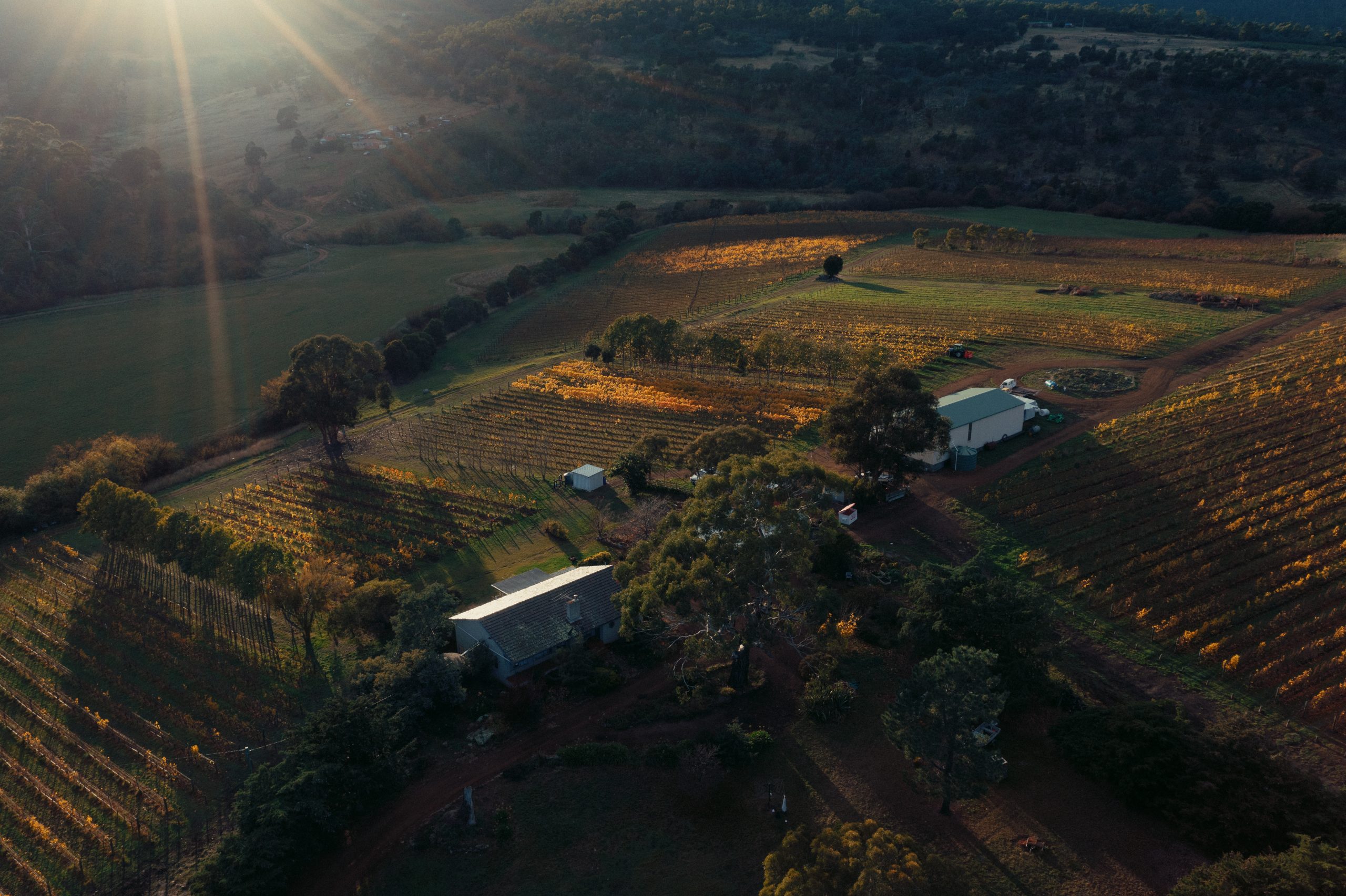About Us
Our Vineyards
Our Region
The Coal River Valley is a historic river plain that has deposits of various alluvial soils in the bends and rivulets of the Coal River. Permian mudstone and sandstone outcrops feature through much of the Valley with Triassic sandstones, shales and coal measures tending to the East.
There are also numerous injections of Jurassic dolerite in pockets of the region. Tertiary basalt sediments and ferricrete deposits are commonly found through the Valley and contribute to our Butchers Hill vineyard’s dark and orange coloured soils. The distinction between our sites is attributed to the historical flow and drainage points of the Coal River.
Our Climate
Our vineyards are located inland from surrounding bodies of water. Our region is considerably drier than our northern and further southern growing counterparts and contributes to more extreme temperatures and conditions throughout the year. While being more continental, the Coal River Valley still enjoys interaction from the surrounding Southern Ocean, allowing us to have a long ripening period moderated by a maritime climate. This creates a beautiful diurnal effect of warm sunny days and cool dewy nights and distinct annual seasons. The lower rainfall of the region presents a great opportunity in reducing disease pressures in our vineyards.

Butcher's Hill, Richmond
Year of first establishment: 2003
SOIL:
Black cracking clay and sandy loams with sandstone composite gravel from sandstone over heavy clay.
ASPECT:
North Facing Slope
ELEVATION:
30m-100m
AREA PLANTED:
6 hectares
VARIETALS:
Chardonnay, Pinot Noir, Riesling and Pinot Grigio
Butchers Hill Vineyard is a prominent feature of the Richmond landscape as it protrudes from its borders. This site’s steep north-facing slope means that it receives some very long sunlight hours, protection from cold southern winds, and increased soil drainage. The iron oxide deposits in our soils allows for heat and water to be held longer as they are darker and more clay based. These soil attributes also interact with the production of flavonoids in the fruit which typically produces complex robust wines.

Cooinda Vale, Campania
Year of first establishment: 1985
SOIL:
Shallow sandy clay loams over impervious clays. Black cracking clays to the north.
ASPECT:
Sheltered North-East facing
ELEVATION:
80m-100m
AREA PLANTED:
12 hectares
VARIETALS:
Chardonnay, Pinot Noir, Syrah, Riesling, Pinot Grigio.
Cooinda Vale Vineyard is tucked away in a nook of hills North of Campania, making it much more protected from prevailing weather conditions. Being more continental, Cooinda Vale also experiences greater extremes in conditions, bringing more frequent frosts, snow, and heatwaves. The shallow, pale sandy soils at this site tend to produce a moderate level of struggle for the vines by restricting deep root growth and water and nutrient accessibility. Fortunately these conditions produce a more delicate and finessed wine.
No wine region in Australia has more potential than Tasmania. Though in ‘wine years’ it is just emerging from the exuberance of adolescence. Tasmania’s unique set of attributes puts it in a strong position heading into the future and the confluence of wine, food, art and natural beauty in a compact package presents an alluring proposal to wine consumers and visitors to the state.
David Brookes, Wine Writer, Gourmet Traveller, Wine Companion
Our Commitment to Sustainable Viticulture
Our mission is to share exceptional, nurtured wines that express our uniqueness, ambassadorship, and dedication to regenerating our environment for generations to come.
From a global perspective, Tasmania’s southern latitude provides an excellent opportunity for producers to future proof themselves from a changing climate. Our strength lies within: our cool climate, natural isolation, and consistent, although low, winter rainfall. Our unique environment allows us to diversify our plantings, maintain strong biosecurity and incorporate organic practices with reduced environmental pressures.
In the context of Pooley Wines, we have a strong focus on biological farming as it uses softer, more naturally derived inputs that support both vine balance and soil ecology. We implement regenerative agricultural practices by dedicating permanent biodiversity zones on our sites to build back the landscape. Additionally, we are committed to upcycling green waste from our vineyards into valuable and available vine nutrition. These foundations are paramount to continued productivity and resilience in a changing climate.
In the winery, our wines are handled gently with minimal intervention. This supports our unwavering quest to capture the truest expression of site in every drop. Having the most natural inputs from vine to wine ensures we are paying homage to terroir and all the stories of that vintage.



